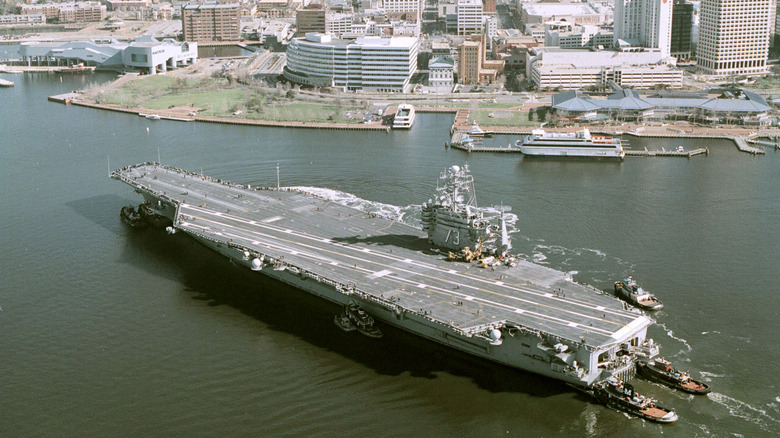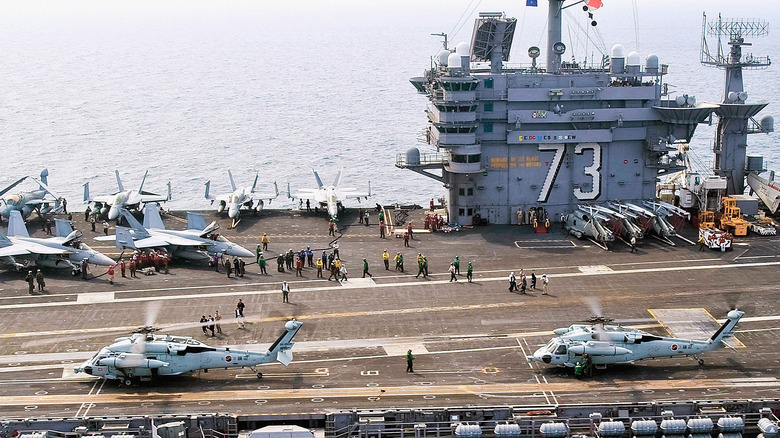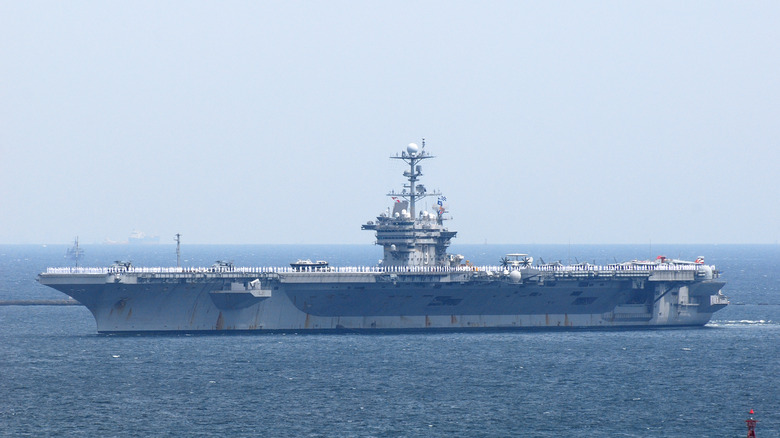The USS George Washington Isn't Even Stationed In The US - Here's Where You'd Have To Go To See It
The USS George Washington, an aircraft carrier of the Nimitz class, is the latest of four U.S. Navy vessels to bear George Washington's name. Led by Commanding Officer Captain Timothy L. Waits, Command Master Chief Antonio L. Roberts, and Executive Officer Captain Patrick E. Blind, this enormous ship is stationed outside of the United States. That means that if you'd like to go and see the majestic vessel for yourself, you might have quite a journey ahead of you.
In July 2025, the USS George Washington was engaged in a tour of the Indo-Pacific, where it stopped for several days in the Philippine's capital of Manila. It was here, reported a press release for the navy, to show "the U.S. Navy and GWA CSG's commitment to strengthening our bonds with allies and partners in the Indo-Pacific theater." The force noted that "routine operations" were performed in the area before the aircraft carrier returned to Yokosuka, Japan, which is presently its home port. While aircraft carriers often travel internationally, the USS George Washington is unique in that it is permanently stationed outside of the United States. That's because it's the navy's only forward-deployed carrier.
The advantages of forward deployment
Diplomatic matters, as with the July 2025 visit to Manila, have to be balanced with duties of defense, surveillance, deterrence, and more. To access a region where any one of these matters needs to be handled quickly, it's enormously useful to be as close as possible. There are more than 750 U.S. bases in and around other nations in the world for that reason. The practice of forward deployment, or basing (in the case of the navy) vessels in strategically important places around the world outside of U.S. waters, is another important tactic to ensure this global responsiveness. In a June 1994 copy of the U.S. Naval Institute's Proceedings journal, Rear Admiral Philip A. Dur wrote that the growth of the U.S. Navy is driven by "the demand for forward naval presence forces built to win wars and positioned to prevent them."
In addition to being able to attend to unfolding situations quicker, using forward deployments also opens up opportunities to work with local partners and allies. Although the USS George Washington is the only forward-deployed carrier presently, there have been others deployed in this way before. The USS America spent six years in Sasebo, on the southwest coast of Japan, before returning to its dock in San Diego in September 2025. The National Interest quotes the vessel's executive officer, Captain Michael Plageman, as stating that representing one's nation so far from home this way is "an incredible challenge and honor."
The USS George Washington is an international heavyweight
The USS George Washington hosts a crew of 5,980 people at any given time. Aircraft carriers of the Nimitz class stretch 1,092 feet long and displace around 97,000 tons. As great a threat as this class of vessels can pose, though, it's vital not to see them as just offensive threats. As a result of their tremendous size and resources, they can also play a critical part in the nation's response to natural disasters and other humanitarian catastrophes around the world, serving as mobile naval bases of sorts as they do.
The USS George Washington, for instance, was forward-deployed to Japan's Yokosuka in 2008. This then meant that, when the nation was struck by a catastrophic earthquake three years later, it could provide support and relief to affected regions. This is one of the oldest aircraft carriers still in service, and it has been deployed for many missions in its more than three decades of operation. The vessel typically splits its time 50-50 between its home region of Japan and the ocean. Overall, the forward deployment saves about ½ a month of travel time that it would take to send another aircraft carrier to the region from the U.S.


